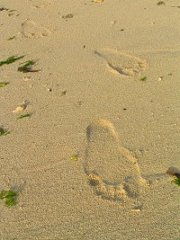 The shifting sands of time have revealed Australia's earliest human footprints, giving a glimpse of life at the height of the last ice age.
The shifting sands of time have revealed Australia's earliest human footprints, giving a glimpse of life at the height of the last ice age.At tens of thousands of years old the find is the largest group of human footprints from the Pleistocene era ever found.
Archaeologist Dr Matthew Cupper of the University of Melbourne and colleagues report their findings from the New South Wales Willandra Lakes World Heritage Area online ahead of print publication in the Journal of Human Evolution.
"It's a little snapshot in time," says Cupper. "The possibilities are endless in terms of getting a window into past Aboriginal society."
Cupper says a young woman by the name of Mary Pappin Jnr of the Mutthi Mutthi people found the footprints in August 2003 while exploring the area with team member Professor Steve Webb of Bond University on Queensland's Gold Coast, as part of a project to educate young Aboriginal people in archaeology.
"They found a clay pan area up in the dunes near one of the lakes and found the first of what's turned out to be about 450 footprints over 700 square metres or so."
He says the team has found 22 trackways, some up to 20 metres long, from where single people had walked in a line.
The prints are between 19,000 and 23,000 years old, dating from the height of the last glacial period.
"It's quite remarkable," says Cupper. "We haven't found any footprints from the Pleistocene in Australia before."
He says the prints are also the largest group of Pleistocene human footprints in the world.
Tag : Anthropology, Australia.